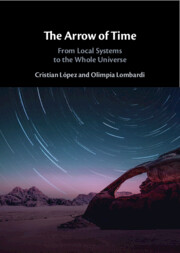Book contents
- The Arrow of Time
- The Arrow of Time
- Copyright page
- Contents
- Contributors
- Preface
- Acknowledgments
- Part I Local Systems
- Part II The Arrow of Time and Philosophical Issues
- 4 Explaining the Psychological Arrow of Time in Time-Symmetric Physics
- 5 The Consequence Argument Meets the Mentaculus
- 6 “Freedom from the Inside Out”: Revisited
- 7 The Arrow of Time Is Alive and Well but Forbidden under the Received View in Physics
- Part III The Arrow of Time and Time-Reversal Invariance
- Part IV The Whole Universe
- Index
- References
6 - “Freedom from the Inside Out”: Revisited
from Part II - The Arrow of Time and Philosophical Issues
Published online by Cambridge University Press: 28 October 2025
- The Arrow of Time
- The Arrow of Time
- Copyright page
- Contents
- Contributors
- Preface
- Acknowledgments
- Part I Local Systems
- Part II The Arrow of Time and Philosophical Issues
- 4 Explaining the Psychological Arrow of Time in Time-Symmetric Physics
- 5 The Consequence Argument Meets the Mentaculus
- 6 “Freedom from the Inside Out”: Revisited
- 7 The Arrow of Time Is Alive and Well but Forbidden under the Received View in Physics
- Part III The Arrow of Time and Time-Reversal Invariance
- Part IV The Whole Universe
- Index
- References
Summary
In a 2002 paper, I offered a novel way of thinking about the compatibility of free will with determinism, one that depended on appealing to the typical understanding of time of the philosopher of physics as simply one of the four dimensions of the Block Universe, albeit an especially interesting and important one. I argued that rejecting the everyday notion of “passage of time,” and of the explanatory privilege that we usually give to past → future determination as opposed to future → past determination, allowed one to articulate a novel way of defending free action in a Block world subject to deterministic laws. The problem is, most of the time these days I no longer believe in the Block and do believe in the passage of time! But I still believe that human action is (often) free, and that physics poses no genuine threat to our freedom. In this paper I will explore how the core idea behind “Freedom from the Inside Out” can be modified to be compatible with a metaphysical picture in which time passes, and explanation is not fully time-symmetric.
Information
- Type
- Chapter
- Information
- The Arrow of TimeFrom Local Systems to the Whole Universe, pp. 126 - 139Publisher: Cambridge University PressPrint publication year: 2025
References
Accessibility standard: WCAG 2.1 AA
Why this information is here
This section outlines the accessibility features of this content - including support for screen readers, full keyboard navigation and high-contrast display options. This may not be relevant for you.Accessibility Information
Content Navigation
Allows you to navigate directly to chapters, sections, or non‐text items through a linked table of contents, reducing the need for extensive scrolling.
Provides an interactive index, letting you go straight to where a term or subject appears in the text without manual searching.
Reading Order & Textual Equivalents
You will encounter all content (including footnotes, captions, etc.) in a clear, sequential flow, making it easier to follow with assistive tools like screen readers.
You get concise descriptions (for images, charts, or media clips), ensuring you do not miss crucial information when visual or audio elements are not accessible.
Visual Accessibility
You will still understand key ideas or prompts without relying solely on colour, which is especially helpful if you have colour vision deficiencies.
Structural and Technical Features
You gain clarity from ARIA (Accessible Rich Internet Applications) roles and attributes, as they help assistive technologies interpret how each part of the content functions.
